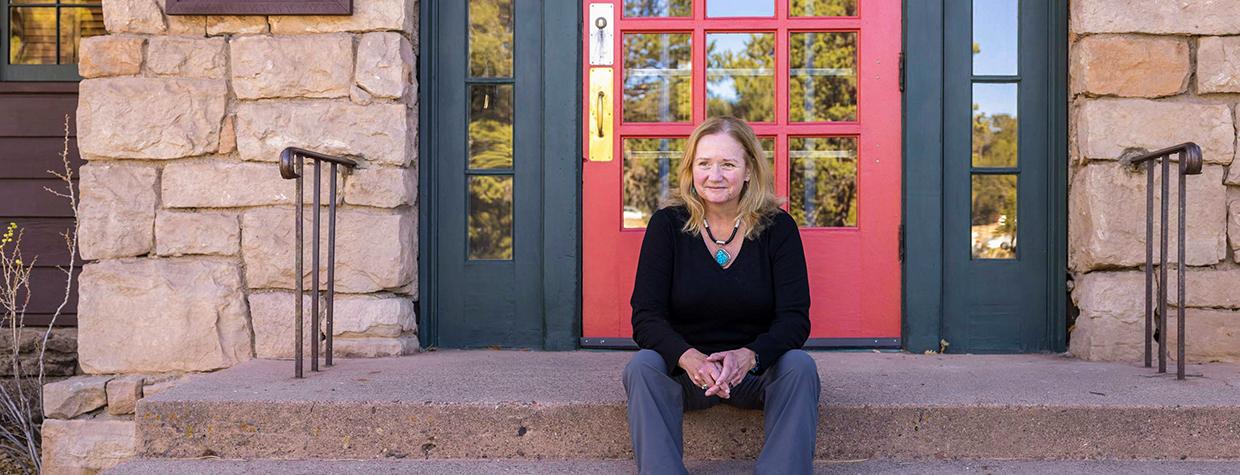The career pinnacle for most successful U.S. attorneys might be a judgeship on a circuit court — or even becoming a Supreme Court justice. Given her professional track record, Camille Bibles (pictured) could easily have followed that path. But she was less interested in climbing the traditional career ladder than she was in climbing the Grand Canyon’s trails. She aspired to a position that would allow her to wear hiking shoes in the courtroom and have one of the world’s most spectacular views right outside her chamber window.
In 2019, Bibles’ dream came true when she was appointed a magistrate judge of the U.S. District Court for the District of Arizona. As the only federal judge in Northern Arizona, Bibles oversees cases involving tribal lands and federal public lands, including Grand Canyon National Park. “This is my dream job, and it’s my last job,” says Bibles, 60, who had been hoping for years to land the coveted magistrate position, an initial eight-year appointment, before she retired. Unlike other federal judges, who are appointed by the president, magistrate judges are selected by other judges in the district.
Bibles started her legal career in 1987, as a prosecutor in the Coconino County Attorney’s Office, and went on to serve as an assistant U.S. attorney in Phoenix and Flagstaff. She took leave twice to work in the International Criminal Tribunal for the former Yugoslavia in The Hague, Netherlands, where she helped prosecute war crimes.
While Bibles is passionate about the law and justice, she’s equally passionate about experiencing wild places: She’s a longtime Canyon backpacker and an avid cyclist and fly fisher.
Bibles hears cases in Flagstaff, in Page, in Kingman and at the Canyon, one of only a few parks in the country with their own courts. Bibles holds court at the Canyon one day a month, and she typically tries to squeeze in a rim-to-river hike to Phantom Ranch the day before, then hike out at dawn the next morning to get to court in time. And it’s not unusual for her to wear her hiking shoes with her robe.
“I cried the first time I left Arizona to work in [Europe],” Bibles recalls. “It wasn’t leaving my house that caused a sense of loss. It was driving away from the Canyon. I knew I wouldn’t be able to return for a long time, and that was very painful.”
Now, Bibles is home for good. And working at the Canyon to protect the place she loves is her ultimate calling. The magistrate position often hears cases involving park visitors who harm or steal wildlife, as well as people who damage geological or archaeological resources. Some other notorious cases included people who BASE jumped off the South Rim or rode a mountain bike from rim to river, in violation of park rules.
But the problem with Bibles’ “home court” when she was appointed in 2019 was that the magistrate courtroom at the South Rim was in terrible shape. “I was concerned about whether the court would even make it through the winter because of the condition of the windows and other issues,” she says.
The building in Grand Canyon Village was constructed in the 1930s as a U.S. post office, and part of it became a courtroom in the 1970s. Over the years, upkeep of the courtroom fell behind. In 2021, a National Park Service maintenance crew worked tirelessly to transform the courtroom into a place befitting its location in a natural wonder. The crew’s efforts have made Bibles confident that the courtroom will last at least a few more decades.
Beyond addressing basic maintenance, Bibles wanted to create an atmosphere that would leave a lasting impression on courtroom visitors, whether they were there willingly or not. “At first, I thought I would put historical images on the walls,” she says. “But then I realized the purpose of this court is not to celebrate people. It is to protect the Canyon and the resource.” She decided the courtroom should be filled with photos showcasing the Canyon’s spectacular beauty and unique wildlife.
Once she knew what she wanted to do, Bibles contacted Rich Rudow, another passionate Canyon hiker and a professional photographer, about putting his images in the magistrate building. Rudow had amassed more than 1 million digital photographs during his 1,200 days below the Canyon’s rim, so deciding which images to use could have been overwhelming. But Bibles had a vision that helped narrow things down: People who harm the Canyon should take a good, long look at the awe-inspiring natural wonder and its creatures.
“You need to reflect on what you’ve done,” Bibles says of those who approach her at the bench. And she means that literally: On one wall of the courtroom is a large photo of a tinaja along the Colorado River mirroring the Canyon walls and sky. And if you’ve done something to harm the park’s wildlife, there are photos of a raven, a bobcat and an elk staring back at you from another wall.
Hanging over the entrance of the courtroom is a large South Rim panorama made at Pima Point at sunset. Soaring through the middle of the scene is a California condor riding a thermal. Potential troublemakers, take note: “That condor is watching over this park,” Bibles says. And so is the new judge.

